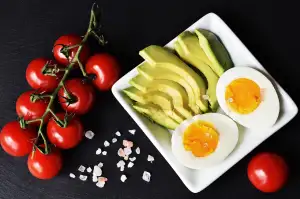Flavorful Delight: Mastering the Leg of Lamb Recipe for a Memorable Feast

- Ingredients required for cooking a leg of lamb
- Preparing the leg of lamb for cooking
- Seasoning the leg of lamb
- Cooking methods for a leg of lamb
- Roasting the leg of lamb
- Grilling the leg of lamb
- Slow cooking the leg of lamb
- Checking the doneness of the leg of lamb
- Resting and serving the leg of lamb
- Tips and variations for the leg of lamb recipe
The leg of lamb is a classic centerpiece for any special occasion feast. Its tender and succulent meat, combined with its rich flavor, makes it a favorite among meat lovers. Whether you're hosting a holiday dinner or simply want to impress your guests with a memorable meal, mastering the leg of lamb recipe is essential. In this article, we will guide you through the steps of preparing and cooking this flavorful delight, ensuring that your next feast is truly unforgettable.
Ingredients required for cooking a leg of lamb
To create a flavorful leg of lamb, you will need the following ingredients:
1. Leg of lamb: Choose a bone-in leg for more flavor or boneless for ease of carving.
2. Garlic cloves: Crushed or minced to infuse the meat with a rich aroma.
3. Fresh rosemary: Adds a fragrant and earthy taste to complement the lamb.
4. Olive oil: Helps to tenderize and moisten the meat while adding a subtle richness.
5. Salt and pepper: Enhances the natural flavors of the lamb.
6. Lemon juice: Adds a tangy brightness that balances out the richness of the meat.
These simple yet essential ingredients will lay the foundation for an exquisite leg of lamb that is sure to impress your guests.
Preparing the leg of lamb for cooking
Preparing the leg of lamb for cooking is an essential step to ensure a flavorful and tender result. Start by trimming any excess fat from the surface of the meat, leaving a thin layer for added flavor. Next, make small incisions all over the leg and insert slivers of garlic or rosemary sprigs into them. This will infuse the meat with aromatic flavors as it cooks. Finally, allow the leg of lamb to come to room temperature before proceeding with seasoning and cooking. This will ensure even cooking and a juicy end result.
Seasoning the leg of lamb
Seasoning the leg of lamb is a crucial step in bringing out its rich and savory flavors. Begin by generously rubbing the leg of lamb with salt and pepper, ensuring that every inch is coated. For an extra burst of flavor, create a marinade using garlic, rosemary, thyme, and olive oil. Massage this mixture into the meat, allowing it to penetrate for at least an hour or overnight in the refrigerator. The herbs will infuse their aromatic essence while the salt and pepper enhance the natural taste of the lamb. Remember, a well-seasoned leg of lamb is the foundation for a truly memorable feast.
Cooking methods for a leg of lamb
Cooking methods for a leg of lamb offer different flavors and textures. Roasting is a classic method that results in tender meat with a crispy exterior. Grilling adds a smoky flavor and beautiful grill marks. Slow cooking produces melt-in-your-mouth meat. Each method requires different temperatures and times, so choose the one that suits your taste and occasion. Experiment with these methods to create a memorable feast that will delight your guests.
Roasting the leg of lamb
Roasting the leg of lamb is a classic and popular method that brings out the rich flavors and tender texture of the meat. Preheat your oven to 350°F (175°C) and place the seasoned leg of lamb on a roasting rack in a shallow pan. Roast for about 20 minutes per pound, or until the internal temperature reaches 145°F (63°C) for medium-rare. Baste the lamb occasionally with its own juices to keep it moist and flavorful. Let it rest for 10-15 minutes before carving into succulent slices. The roasted leg of lamb will be beautifully browned on the outside and juicy on the inside, making it an irresistible centerpiece for any feast.
Grilling the leg of lamb
Grilling the leg of lamb adds a smoky and charred flavor that enhances its natural richness. To grill the leg of lamb, preheat the grill to medium-high heat. Place the marinated leg on the grill and cook for about 15-20 minutes per side, or until it reaches an internal temperature of 145°F for medium-rare. Baste with any remaining marinade during cooking for added flavor. Remember to let it rest before slicing to allow the juices to redistribute. Grilled leg of lamb is perfect for outdoor gatherings and pairs well with fresh herbs or a tangy mint sauce.
Slow cooking the leg of lamb
Slow cooking the leg of lamb is a method that requires patience but promises tender and succulent meat. To begin, preheat your oven to a low temperature, around 275°F (135°C). Place the seasoned leg of lamb in a roasting pan and cover it tightly with foil. Slowly cook the lamb for several hours, allowing the flavors to develop and the meat to become fork-tender. This low and slow cooking method ensures that every bite is packed with flavor and melts in your mouth. Remember to periodically baste the lamb with its juices to keep it moist and flavorful. Slow cooking is perfect for those who prefer a hands-off approach, as it allows you to focus on other tasks while the lamb cooks to perfection.
Checking the doneness of the leg of lamb
Checking the doneness of the leg of lamb is crucial to ensure a perfectly cooked and flavorful dish. There are a few methods you can use to determine if your leg of lamb is cooked to perfection. One way is to use a meat thermometer and insert it into the thickest part of the meat. For medium-rare, the internal temperature should be around 145°F (63°C), for medium it should be around 160°F (71°C), and for well-done it should be around 170°F (77°C). Another method is to use a fork or knife to make a small incision in the thickest part of the meat. If the juices run clear and the meat is tender, it is likely done. Remember that the leg of lamb will continue cooking as it rests, so it's best to remove it from heat just before reaching your desired doneness.
Resting and serving the leg of lamb
Resting the leg of lamb is a crucial step to ensure a tender and juicy result. Once cooked, remove the leg from the heat source and let it rest for about 15-20 minutes. This allows the juices to redistribute throughout the meat, resulting in a more flavorful and succulent dish.
While the leg of lamb is resting, cover it loosely with aluminum foil to keep it warm. This also helps retain its moisture. Use this time to prepare any accompanying sauces or side dishes.
When ready to serve, carve the leg of lamb into thin slices against the grain. This will make it easier to chew and enhance its tenderness. Arrange the slices on a serving platter, garnish with fresh herbs or lemon wedges for an added touch of freshness.
Pair your leg of lamb with roasted vegetables, creamy mashed potatoes, or a refreshing salad. The rich flavors of the meat will complement these sides perfectly.
Remember, presentation is key when serving such an exquisite dish. Take your time arranging the slices on each plate and drizzle some pan juices over them for extra flavor. Your guests will be impressed by both the taste and visual appeal of this flavorful masterpiece.
Now that you have mastered the art of cooking a leg of lamb, it's time to gather your loved ones around the table and indulge in this memorable feast. Enjoy every bite and savor the deliciousness that comes from mastering this classic recipe!
Tips and variations for the leg of lamb recipe
Tips and Variations for the Leg of Lamb Recipe:
1. For added flavor, marinate the leg of lamb overnight in a mixture of olive oil, garlic, lemon juice, and your favorite herbs and spices.
2. To enhance the tenderness of the meat, try using a meat tenderizer or scoring the surface of the lamb before seasoning.
3. Experiment with different seasonings such as rosemary, thyme, cumin, or paprika to create unique flavor profiles.
4. For a Mediterranean twist, stuff the leg of lamb with a mixture of feta cheese, spinach, and sun-dried tomatoes before cooking.
5. If you prefer a crispy exterior, sear the leg of lamb on high heat for a few minutes before roasting or grilling.
6. Add vegetables like potatoes, carrots, and onions to the roasting pan for a complete one-pot meal.
7. For a smoky flavor, use wood chips when grilling the leg of lamb or add liquid smoke to your marinade.
8. Consider serving the leg of lamb with mint jelly or tzatziki sauce for an extra burst of freshness.
9. Don't be afraid to experiment with different cooking methods such as sous vide or braising for unique textures and flavors.
10. Leftover cooked leg of lamb can be used in sandwiches, salads, or even as filling for tacos or wraps.
By following these tips and exploring variations in seasoning and cooking methods, you can elevate your leg of lamb recipe to new heights and create a memorable feast for your guests.
In conclusion, mastering the leg of lamb recipe is a surefire way to create a memorable feast. The combination of tender meat and flavorful seasoning makes this dish a crowd-pleaser. Whether you choose to roast, grill, or slow cook the leg of lamb, the end result will be a succulent and delicious centerpiece for any meal. Remember to check the doneness of the meat using a meat thermometer and allow it to rest before serving. With these tips and variations, you can customize the recipe to your liking and impress your guests with your culinary skills. So go ahead and give this leg of lamb recipe a try - it's guaranteed to be a flavorful delight!
Published: 27. 01. 2024
Category: Recipes



